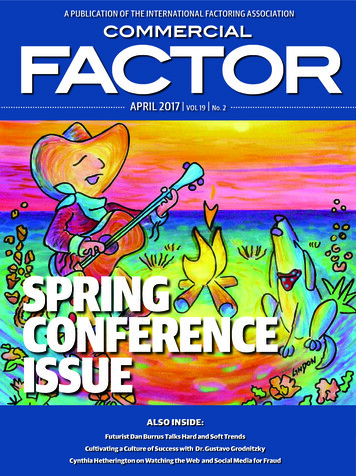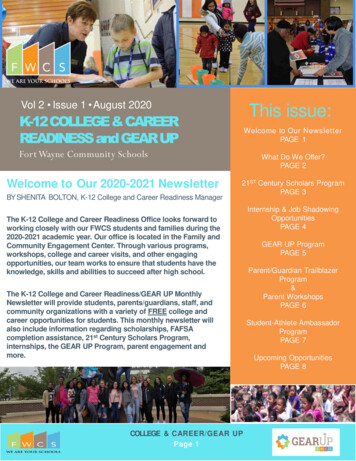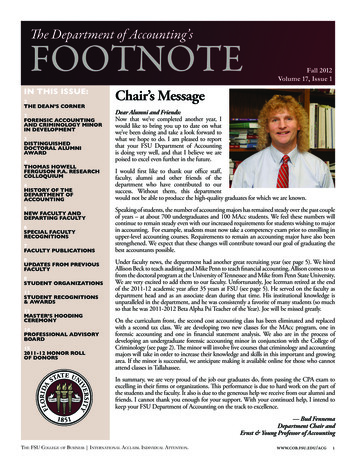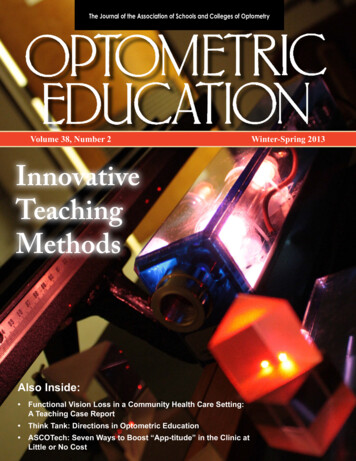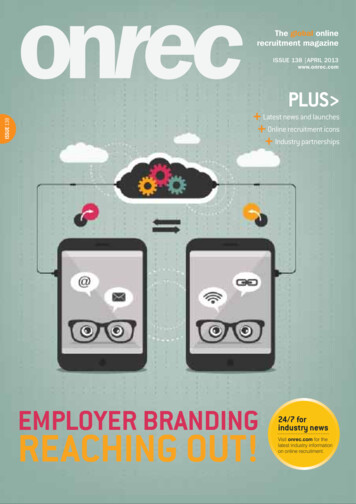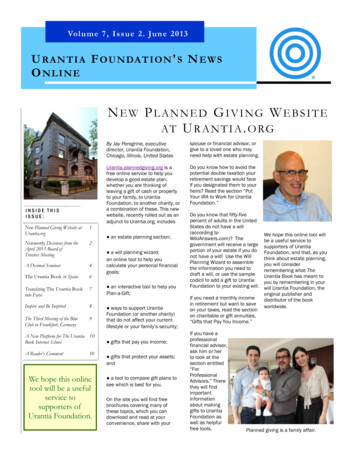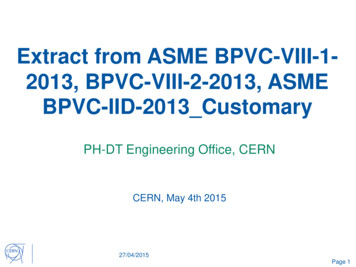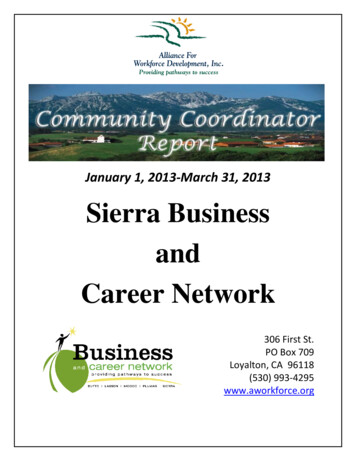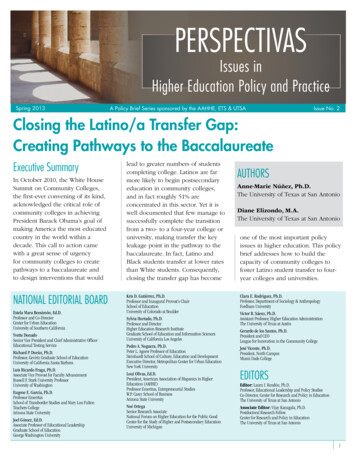
Transcription
PERSPECTIVASIssues inHigher Education Policy and PracticeSpring 2013A Policy Brief Series sponsored by the AAHHE, ETS & UTSAIssue No. 2Closing the Latino/a Transfer Gap:Creating Pathways to the BaccalaureateExecutive SummaryIn October 2010, the White HouseSummit on Community Colleges,the first-ever convening of its kind,acknowledged the critical role ofcommunity colleges in achievingPresident Barack Obama’s goal ofmaking America the most educatedcountry in the world within adecade. This call to action camewith a great sense of urgencyfor community colleges to createpathways to a baccalaureate andto design interventions that wouldNATIONAL EDITORIAL BOARDEstela Mara Bensimón, Ed.D.Professor and Co-DirectorCenter for Urban EducationUniversity of Southern CaliforniaYvette DonadoSenior Vice President and Chief Administrative OfficerEducational Testing ServiceRichard P. Durán, Ph.D.Professor, Gevirtz Graduate School of EducationUniversity of California Santa BarbaraLuis Ricardo Fraga, Ph.D.Associate Vice Provost for Faculty AdvancementRussell F. Stark University ProfessorUniversity of WashingtonEugene E. García, Ph.D.Professor EmeritusSchool of Transborder Studies and Mary Lou FultonTeachers CollegeArizona State UniversityJoel Gómez, Ed.D.Associate Professor of Educational LeadershipGraduate School of EducationGeorge Washington Universitylead to greater numbers of studentscompleting college. Latinos are farmore likely to begin postsecondaryeducation in community colleges,and in fact roughly 51% areconcentrated in this sector. Yet it iswell documented that few manage tosuccessfully complete the transitionfrom a two- to a four-year college oruniversity, making transfer the keyleakage point in the pathway to thebaccalaureate. In fact, Latino andBlack students transfer at lower ratesthan White students. Consequently,closing the transfer gap has becomeKris D. Gutiérrez, Ph.D.Professor and Inaugural Provost’s ChairSchool of EducationUniversity of Colorado at BoulderSylvia Hurtado, Ph.D.Professor and DirectorHigher Education Research InstituteGraduate School of Education and Information SciencesUniversity of California Los AngelesPedro A. Noguera, Ph.D.Peter L. Agnew Professor of EducationSteinhardt School of Culture, Education and DevelopmentExecutive Director, Metropolitan Center for Urban EducationNew York UniversityLoui Olivas, Ed.D.President, American Association of Hispanics in HigherEducation (AAHHE)Professor Emeritus, Entrepreneurial StudiesW.P. Carey School of BusinessArizona State UniversityNoé OrtegaSenior Research AssociateNational Forum on Higher Education for the Public GoodCenter for the Study of Higher and Postsecondary EducationUniversity of MichiganAUTHORSAnne-Marie Núñez, Ph.D.The University of Texas at San AntonioDiane Elizondo, M.A.The University of Texas at San Antonioone of the most important policyissues in higher education. This policybrief addresses how to build thecapacity of community colleges tofoster Latino student transfer to fouryear colleges and universities.Clara E. Rodríguez, Ph.D.Professor, Department of Sociology & AnthropologyFordham UniversityVictor B. Sáenz, Ph.D.Assistant Professor, Higher Education AdministrationThe University of Texas at AustinGerardo de los Santos, Ph.D.President and CEOLeague for Innovation in the Community CollegeJosé Vicente, Ph.D.President, North CampusMiami Dade CollegeEDITORSEditor: Laura I. Rendón, Ph.D.Professor, Educational Leadership and Policy StudiesCo-Director, Center for Research and Policy in EducationThe University of Texas at San AntonioAssociate Editor: Vijay Kanagala, Ph.D.Postdoctoral Research FellowCenter for Research and Policy in EducationThe University of Texas at San Antonio1
Closing the Latino/a Transfer Gap: Creating Pathways to the BaccalaureateIntroductionFigure 1. Percentage of Racial/Ethnic Groups in Poverty Using Supplementary Poverty MeasureAlthough Latinos1 have become thelargest population of color in both theUnited States and in higher education,their economic opportunities have notkept pace with this growth. In 2011,Latinos became the largest group ofstudents of color on the nation’s twoand four-year campuses. While Latinosrepresented 13% of all 18- to 24-yearolds enrolled on the nation’s four-yearcampuses, they represented twice asmany students — 25% — on two-yearcampuses (Fry & López, 2012). Despitethese advances in college enrollment, one in five Latinos (19%),half the proportion of Whites(39%), works in management,science, law, education, thearts and health care fields Latinos’ supplemental poverty ratenow exceeds that of other racial/ethnicgroups — 28%, compared with 25% forBlacks, 17% for Asian Americans, and11% for Whites (López & Cohn, 2011)(See Figure 1). One reason for this isLatinos’ concentration in lower-payingoccupations. Just one in five Latinos(19%), half the proportion of Whites(39%), works in management, science,law, education, the arts and health carefields (Pew Hispanic Center, 2010).2Many of these occupations requirea bachelor’s degree. Latinos,however, lag behind other groups ininitiating postsecondary education atbaccalaureate institutions. In 2010,one-fifth of Latino young adults(18–24 years of age), comparedwith one-fourth (25%) of Whitesor Blacks, and over half (51%) ofAsian Americans, were enrolled infour-year postsecondary education(Fry & López, 2012). Latinos are far216All17Asian American28HispanicWhiteSupplemental PovertyMeasure25Black11Source: Adapted from “Hispanic Poverty Rate Highest in New Supplemental Census Measure,” by M.H. López and D. Cohn, D., 2011.Copyright 2011 by the Pew Hispanic Center.more likely to begin postsecondaryeducation in community colleges. In2009, 51% of first-time Latino collegestudents were enrolled in communitycolleges, compared with 43% of allcollege students (American Associationof Community Colleges, 2012).Community colleges are the key tohigher education institutions thatprovide a critical pathway to thebaccalaureate. Notably, over one-third(35%) of Latinos who earn bachelor’sdegrees were once transfer studentsfrom two-year colleges, comparedwith 27% of White, 26% of Black, and31% of Asian American baccalaureatedegree recipients (Cataldi et al.,2011). Yet it is well documented thatalthough many Latino students whobegin community college intend totransfer, few do (Arbona & Nora,2007; Crisp & Núñez, 2011; Gándara,Alvarado, Driscoll, & Orfield, 2012;Solórzano, Villalpando, & Oseguera,2005). Therefore, transfer is a key“leakage point in the educationalpipeline” (Solórzano et al., 2005,p. 277) for Latinos wishing tocomplete bachelor’s degrees. Giventhis transfer gap, the purpose of thispolicy brief is to address how to buildthe capacity of community colleges tofoster Latino student transfer to fouryear colleges and universities. over one-third (35%) of Latinos who earn bachelor’s degreeswere once transfer students from two-year colleges, comparedwith 27% of White, 26% of Black, and 31% of Asian Americanbaccalaureate degree recipients 12I n this brief, the terms Latino and Hispanic are used interchangeably. Since Hispanic is often used in collecting federal data for race andethnicity, the term is used in reference to the statistics collected. Additionally, the term Latino includes both females (Latinas) and males(Latinos). Supplemental poverty rate is an alternative metric used by the U.S. Census Bureau that includes factors beyond income, such as the localcost of living and the family’s receipt of food stamps, housing subsidies and school lunches, to determine poverty status.
PERSPECTIVAS: Issues in Higher Education Policy and PracticeCommunity CollegeTransfer GapMany Latino college studentsbegin postsecondary educationin community colleges. A U.S.Department of Education studytracking high school graduates fromthe 2003–2004 academic year foundthat nearly half (46%) of Latinostudents, compared with 28%, 30%,and 25% of White, Black, and AsianAmerican students, respectively,enrolled in a community collegeimmediately after completing highschool (NCES, 2008) (See Figure 2).That is, these Latino high schoolgraduates were at least one and onehalf times as likely as others to beginat a community college. Among thissame group of students two yearslater, 32% of Latinos, comparedwith 26% of Blacks, 19% of Whites,and 12% of Asian Americans, werestill enrolled in community colleges(Posselt, Jaquette, Bielby, & Bastedo,2012, Supplementary Table S8). InCalifornia, the state with the largestcommunity college system, sevenin ten (69%) Latino students begintheir postsecondary educationin community colleges (Gándaraet al., 2012).Unfortunately, community collegeenrollment does not necessarilytranslate to significant academicoutcomes for Latino students. Amonga national sample of beginningcommunity college students in 2004,nearly half (48%) of Latino students,compared with two-thirds (66%)of White, half (51%) of Black, andseven in ten (69%) Asian Americanstudents either were still pursuingpostsecondary education or hadearned a postsecondary credential(e.g., certificate, associate degree,or bachelor’s degree) within sixFigure 2. Percentage of High School Graduates from Different Racial/Ethnic Groups Enrolled inCommunity Colleges504640303230262825Immediately FollowingHigh School Graduation1920Two Years After High School12100BlackAsianAmericanLatinoWhiteSource: Adapted from “The Condition of Education 2008,” by the National Center for Education Statistics (NCES), 2008. Copyright 2008 by theNational Center for Education Statistics, and “Access without equity: Longitudinal analyses of institutional stratification by race and ethnicity,” byJ.R. Posselt, O. Jaquette, R. Bielby, & M. Bastedo, 2012, American Educational Research Journal, supplementary table S8.Copyright 2012 by the American Educational Research Association.years (Radford, Berkner, Wheeless,& Sheperd, 2010, p. 10). While half(51%) of these Latino students hadinitially expressed an intention totransfer (Núñez, Sparks, & Hernández,2011), a very small number (14%) hadearned a bachelor’s degree or werestill enrolled in a four-year institutionwithin six years (Radford et al., 2010,p. 10) (see Figure 3).Similarly, in their analysis trackingLatinos’ educational pathways fromelementary to graduate school,Solórzano and colleagues (2005) founda 10% transfer rate for beginningcommunity college Latino students,and concluded that transfer is oneof the most, if not the most, criticalleakage points in the educationalpipeline for Latino students. In anotherstudy of Latino high school graduateswho began postsecondary educationat a community college, just 7% hadattained a bachelor’s degree, comparedwith 44% of those who began at afour-year institution, within eight yearsof beginning college (Arbona & Nora,2007). Even controlling for students’baccalaureate intentions, other sociodemographic characteristics, academicpreparation, college experiences andinstitutional characteristics, Crisp andNúñez (2011) found that Latino andBlack first-time beginning communitycollege students still transferred atlower rates than White students.They found that these students weremore likely than White studentsto be channeled into vocationalprograms, versus the academicprograms that would prepare themto transfer, and that participating invocational programs had a negativeeffect on transfer. In sum, these lowtransfer patterns have significantlycontributed to Latinos’ relatively lowpostsecondary educational attainmentrates (Arbona & Nora, 2007; Bowen,Chingos, & McPherson, 2009).3
Closing the Latino/a Transfer Gap: Creating Pathways to the BaccalaureateFigure 3. Percentage of Students Who Began Community College in 2004 and Had Completed or Were StillEnrolled in a Bachelor’s Degree Program in 200940 F inding the community college tobe an affirming and welcomingenvironment for students withsimilar backgrounds.35301725Still Enrolled in a Four-YearInstitution201950Earned a Bachelorʼs urce: Adapted from “Persistence and Attainment of 2003–4 Beginning Postsecondary Students: After 6 Years (NCES 2011-151),” by A.W. Radford,L. Berkner, B. Wheeless, and B. Shepherd 2010, p. 10. Copyright 2010 by the National Center for Education Statistics.Barriers to TransferLatino community college studentsface several academic, financial,social and cultural barriers to transfer.These are discussed in greater detailin other sources (e.g., Nora & Crisp,2009; Núñez, Hoover, Pickett, StuartCarruthers, & Vázquez, in press), andwe discuss them briefly here.Academic Barriers. These include: A cademic under-preparation forcollege level work (Oakes et al.,2006) P ossibility of delayed enrollmentin college-level courses whendevelopmental education isnecessary to compensate for thatunder-preparation (Gándara et al.,2012; Razfar & Simon, 2011) L imited capacity to becomeengaged in their studies.The last academic barrier, in particular,is shaped by financial, social andcultural factors.4 A ccessing critical information tonavigate collegeFinancial Challenges. Four in ten(39%) Latino community collegestudents come from low-incomebackgrounds (Núñez et al., 2011).Consequently, many Latino studentsmust work to finance their educations,live at home, and/or take care ofsiblings, parents, or extended familyat home. These responsibilities canpull students away from devotingtime to their studies, a processknown as “environmental pull” (Nora& Crisp, 2009). Latino communitycollege students experience moreenvironmental pull characteristicsthan members of other racial/ethnicgroups (Núñez et al., 2011). They aremore likely than others to work duringcollege to finance their education,often using funds to support theirfamilies as well (Dowd & Malcom,2012; Malcom, Dowd, & Yu, 2010).Social and Cultural Challenges. Thesocial and cultural challenges Latinostudents face include: B uilding relationships withcommunity college faculty and staffThe majority (68%) of Latinocommunity college students arefirst-generation college students, andone-third (33%) are first-generationimmigrants (Núñez et al., 2011).These students may have limitedknowledge about the process ofchoosing academic coursework toapplying to transfer, or may havedifficulties finding institutionalpersonnel whom they can trust andwho can guide them in these areas(Bensimon & Dowd, 2009; Hagedorn,2010). Furthermore, they can find thecommunity college to be an alienatingenvironment when the organizationalculture is not responsive to Latinoconcerns ( Jaffe, 2007; Millward,Starkey, & Starkey, 2007).Framework to Address TransferTo build a pathway to thebaccalaureate, it is important that aframework be established to addresstransfer. This framework must include: A cademic capital – collegepreparation F inancial capital – economicresources C ultural capital – informationabout how to navigate the highereducation system S ocial capital – supportiverelationships with collegepersonnel (Núñez, 2009; Núñez, inpress; Núñez et al., in press).
PERSPECTIVAS: Issues in Higher Education Policy and PracticeFurthermore, this framework mustalso take into account Latino culturalorientations and related assets, or“community cultural wealth” (Yosso,2005) of the following types: A spirational – high hopes anddreams for the future; ability to seepossibilitiesand to strengthen their intent to persistand transfer (Barnett, 2011a, 2011b).The quality of faculty-studentinteractions can support Latinostudents toward advancing theireducational goals (Cejda, Casparis,Rhodes, & Seal-Nyman, 2008; Cejda& Hoover, 2010–11). Informed andcaring guidance from “transfer agents”or “transfer champions” can keepLatino community college studentson the transfer path (Bensimon &Dowd, 2009; Dowd et al., 2006).Sometimes community college facultytake the initiative for handling theseresponsibilities. As one communitydo, just let me know’ — without anyjudgment implied — gives [Latinostudents] the confidence they needto come to me for assistance, and thedynamic shifts. Students choose thefaculty member with whom they feelmost comfortable, or the one who isavailable” (Millward et al., 2007, p. 53).In reaching out to Latino students,it is important for faculty andstudent affairs professionals tocultivate self-reflection to exploretheir own backgrounds, prejudices F amilial – knowledge createdand assumptions when assessingthrough sense of community andLatino students’ capabilities. Equallyfamily historyimportant is understanding moreabout the needs of the specific S ocial – information gained“A well placed ‘I know you are having a Latino students they arethrough peer and socialserving (Kirklighter, Cárdenas,difficult time right now. If there is anything & Murphy, 2007; Núñez,networksI can do, just let me know’ — without Murakami, & Cuero, 2010; N avigational – ability toMcEwen, Rendón, &any judgment implied — gives [Latino Patton,navigate racially/ethnicallyHoward-Hamilton, 2007). Thishostile campus experiencesstudents] the confidence they need to come kind of awareness can enhanceto me for assistance, and the dynamic institutional faculty and staff R esistant – ability to resistcapabilities to develop moreshifts. Students choose the faculty member supportive environments thatsubordination and tochallenge inequalities.with whom they feel most comfortable, or are culturally responsiveto Latino communitytheonewhoisavailable”college students.The Role of Faculty L inguistic – intellectual and socialskills attained through use of morethan one languageand StaffFaculty, administrators and otherstaff can serve as “institutionalagents” (Stanton-Salazar, 1997, 2001)to offer Latino students guidance,encouragement and informationto navigate the community collegesystem and progress toward a fouryear degree. When institutional agentsoffer academic and interpersonal“validation” (Rendón, 1994; RendónLinares & Muñoz, 2011) — thatis, when they take the initiative tounderstand students’ backgrounds,develop students’ skills and encouragestudents in their educational progress— Latino community collegestudents are more likely to becomeacademically engaged in their studiescollege writing instructor in aHispanic-Serving Institution3 (HSI)described, “I have become an informalcounselor, advising students onrequired classes and what majorsthey may pursue and informingthem of financial aid opportunities.Nothing in graduate school preparesus for these multiple roles, and notall teachers are willing to take themon” (Millward et al., 2007, p. 38).Another community college instructorfocused on Latino community collegestudent success said, “A well placed ‘Iknow you are having a difficult timeright now. If there is anything I can3Institutional Practices thatPromote TransferSupport to transfer, however, cannotbe left solely to the serendipitousinteractions between individualsand institutional agents. Promisingprograms that promote transfer arediscussed below, although we cautionthat rigorous evaluations of collegeaccess and success programs havetypically been limited (e.g., Crisp &Taggart, 2013; Gándara, 2001).H ispanic-Serving Institutions (HSIs) are defined as two- or four-year, accredited, degree-granting, not-for-profit colleges and universitiesthat enroll at least 25% or more full-time equivalent Hispanic undergraduates (Santiago, 2006, 2007).5
Closing the Latino/a Transfer Gap: Creating Pathways to the BaccalaureateBridge Programs. Bridge programstypically engage incoming communitycollege students in academic classes,brief review sessions, or orientationsjust prior to college, so that studentscan be better prepared for collegelevel work when they begin formalstudies. These programs can sharpenstudents’ academic skills, helpsocialize students toward becomingcollege students, and inform themabout how to seek academic supportonce they begin college (Barnett etal., 2012; Flores et al., 2003; Tierney,Bailey, Constantine, Finkelstein, &Hurd, 2009). In ad
(35%) of Latinos who earn bachelor’s degrees were once transfer students from two-year colleges, compared with 27% of White, 26% of Black, and 31% of Asian American baccalaureate degree recipients (Cataldi et a
